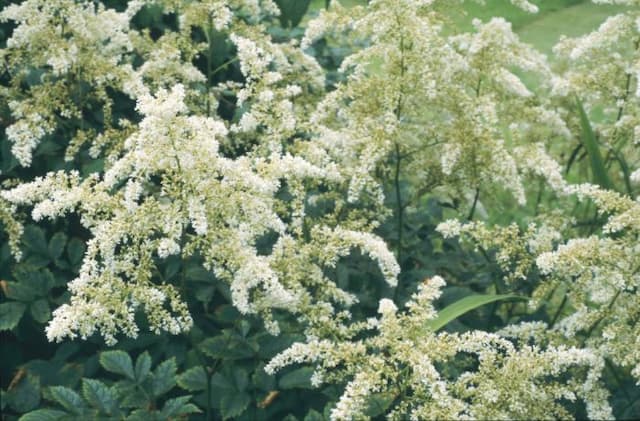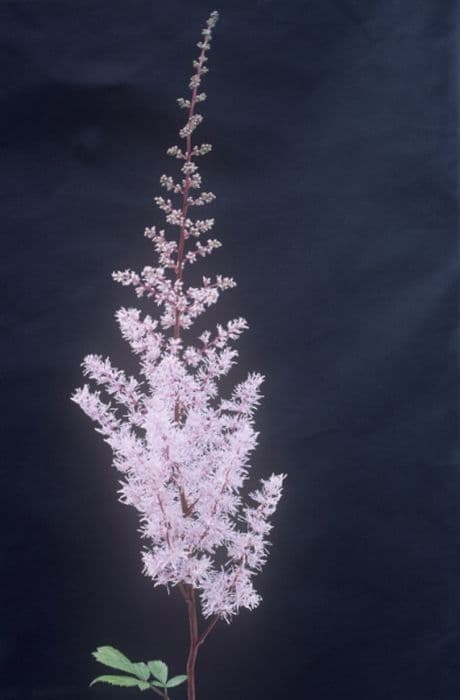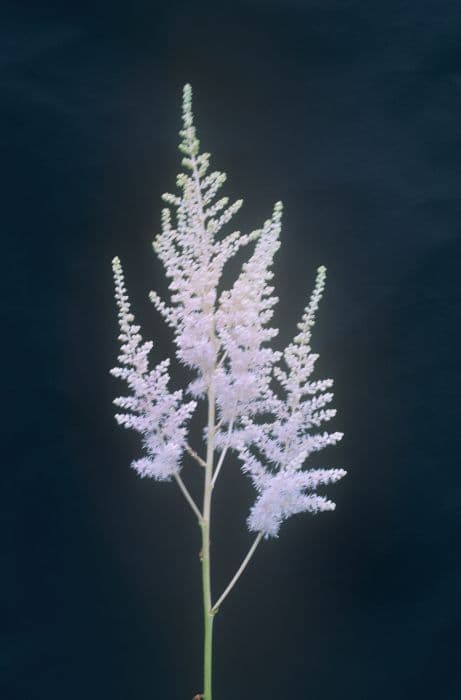False Spirea Astilbe 'Mainz' (japonica hybrid)

ABOUT
The Astilbe 'Mainz' is a perennial plant known for its showy and feathery flower plumes, which present themselves in lovely shades of pink. The blooms rise gracefully above the mound of fern-like, deep green foliage that has a glossy appearance and a finely divided texture, contributing to the overall lusciousness of the plant. The flowering plumes are dense and fluffy, making them stand out in any garden setting, and they bloom in late spring to early summer, adding a delightful touch of color to the landscape during this time. The leaves of the Astilbe 'Mainz' are just as attractive as its flowers, with many small, serrated leaflets per leaf, creating a ferny appearance that is rich and full. The contrast between the delicate flowers and the more substantial foliage is one of the unique visual appeals of this plant. The foliage tends to remain attractive throughout the growing season, providing a nice background for the flowers and other plants in the garden. This plant can contribute to a charming and enchanted garden atmosphere, with its feathery flowers often attracting butterflies and other pollinators.
About this plant
 Names
NamesFamily
Saxifragaceae
Synonyms
False Goat's Beard, False Spirea
Common names
Astilbe 'Mainz' (japonica hybrid).
 Toxicity
ToxicityTo humans
Astilbe 'Mainz' is not considered to be toxic to humans. There are no common symptoms associated with poisoning because this plant is generally recognized as safe if accidentally ingested. However, it is always recommended that no plant material should be eaten unless it is known to be edible, to avoid potential allergic reactions or gastrointestinal discomfort.
To pets
Astilbe 'Mainz' is also not considered to be toxic to pets. There are no specific symptoms of poisoning from this plant for pets like cats and dogs because it is not known to be harmful to animals. However, as with humans, it's wise to prevent pets from consuming plants not intended for consumption to avoid any potential stomach upset or allergic reactions.
 Characteristics
CharacteristicsLife cycle
Perennials
Foliage type
Deciduous
Color of leaves
Green
Flower color
Pink
Height
2 feet [60 cm]
Spread
2 feet [60 cm]
Plant type
Herb
Hardiness zones
4
Native area
Asia
Benefits
 General Benefits
General Benefits- Attractive to Pollinators: Astilbe 'Mainz' flowers attract butterflies and other pollinators, enhancing biodiversity in the garden.
- Shade Tolerance: They can thrive in partial to full shade, making them ideal for woodland gardens or areas with dappled sunlight.
- Low Maintenance: Once established, Astilbe 'Mainz' require relatively little care, making them suitable for gardeners of all skill levels.
- Showy Flowers: Their plume-like flowers add visual interest to the garden from late spring to midsummer.
- Good for Cut Flowers: The blooms can be used in fresh floral arrangements, adding beauty both in the garden and indoors.
- Color Variety: Astilbe 'Mainz' provides a range of colors through its blooms and foliage, enhancing the garden palette.
- Erosion Control: Their root system helps to stabilize the soil, making them a practical choice for slopes and areas prone to erosion.
- Seasonal Interest: They offer four-season interest with flowers in warmer months and seed heads and foliage in fall and winter.
- Deer and Rabbit Resistant: The plant is less palatable to deer and rabbits, which can help reduce damage in the garden.
 Medical Properties
Medical PropertiesThis plant is not used for medical purposes.
 Air-purifying Qualities
Air-purifying QualitiesThis plant is not specifically known for air purifying qualities.
 Other Uses
Other Uses- Astilbe can be used in dried flower arrangements. Once the blooms have faded, they can be cut and hung upside down in a dry, airy space to preserve them.
- In art, the delicate structure of dried Astilbe flowers can be incorporated into mixed-media projects, providing texture and a touch of natural beauty.
- Astilbe is sometimes used in educational settings for botanical studies because of its distinct foliage and flowering patterns.
- The strong, feathery plumes of Astilbe are sometimes used in fashion for creating unique and natural-themed accessories.
- Due to its attractive foliage, Astilbe is often used in photography as a backdrop or an accent piece to add depth and interest to the composition.
- As a ground cover plant, Astilbe can also play a role in soil erosion control on sloped garden areas with its network of roots.
- The plant can be used in water garden designs, planted around ponds or streams, to enhance the aesthetic of aquatic landscaping.
- Some gardeners may use Astilbe to create natural dyes, as certain plant parts can produce subtle colors when treated correctly.
- Astilbe can be included in sensory gardens to provide a tactile experience, as the feathery flowers have a unique texture to touch.
- In culinary arts, although not widely practiced, the flowers could be used as a delicate garnish for salads and desserts for special occasions.
Interesting Facts
 Feng Shui
Feng ShuiThe Astilbe is not used in Feng Shui practice.
 Zodiac Sign Compitability
Zodiac Sign CompitabilityThe Astilbe is not used in astrology practice.
 Plant Symbolism
Plant Symbolism- Patient Love: Astilbe often symbolizes a devoted and patient love, due in part to its soft and feathery plumes that take time to grow and flourish.
- Dedications and Commitments: As a plant that returns faithfully each year, Astilbe can represent the idea of lifelong commitments and enduring promises in relationships.
- Hope and Positivity: With its bright and attractive flowers, Astilbe can embody hope, optimism, and the expectation of good things to come.
 Water
WaterFalse Spirea prefers consistently moist soil, so it is important to water the plant regularly. Ideally, water the plant thoroughly once a week, providing enough water to soak the soil to a depth of at least 6 inches. During hot and dry weather, increase watering frequency to twice a week. Each watering session should involve applying approximately half a gallon to ensure adequate soil moisture. Make sure the soil is well-draining to prevent waterlogging.
 Light
LightFalse Spirea thrives in partial shade to full shade conditions. The ideal spot for the plant would be in a garden area that receives filtered sunlight or light dappled shade throughout the day. Avoid placing it in full sun, as this can lead to scorched leaves and stress the plant.
 Temperature
TemperatureThe False Spirea is hardy and can tolerate a range of temperatures. This plant can survive minimum temperatures as low as 20 degrees Fahrenheit and can handle maximum temperatures around 80 degrees Fahrenheit. The ideal temperature range for this plant is between 60 and 70 degrees Fahrenheit for optimal growth.
 Pruning
PruningFalse Spirea benefits from pruning to remove spent flowers and to maintain its shape. Pruning should be done in late winter or early spring before new growth begins. Cut back the plant by about a third of its size to promote vigorous new growth and improve air circulation. Pruning once a year is typically sufficient.
 Cleaning
CleaningAs needed
 Soil
SoilFalse Spirea thrives in a well-draining, moisture-retentive soil mix with an acidic to neutral pH between 6.0 and 7.0. A mix of loam, peat moss, and perlite or coarse sand in equal parts is ideal to provide the necessary aeration and moisture retention for healthy growth.
 Repotting
RepottingFalse Spirea typically doesn't require frequent repotting and can be repotted every 2-3 years or when it has outgrown its current container. Repotting in the spring is advisable as the plant enters a period of active growth.
 Humidity & Misting
Humidity & MistingFalse Spirea prefers high humidity levels but is quite adaptable to average household humidity. For optimal growth, maintaining a relative humidity of around 60% is beneficial for this plant.
 Suitable locations
Suitable locationsIndoor
Place False Spirea in indirect light and keep soil moist.
Outdoor
Plant in partial shade, moist soil, and mulch to retain moisture.
Hardiness zone
4-8 USDA
 Life cycle
Life cycleThe life cycle of the Astilbe 'Mainz', commonly known as False Spirea, begins with germination, where the plant emerges from seeds or is propagated through division in spring. It then enters the vegetative stage, developing a rosette of fern-like foliage, and as temperatures rise in late spring to early summer, it progresses to the flowering stage, producing feathery plumes in shades of pink, red, or white. After pollination, typically by insects, the flowers fade and the plant produces seed capsules through the summer, completing the reproductive stage. In fall, the foliage may change color, and the plant enters a period of dormancy over winter, with the underground rhizomes surviving the cold. With the return of warmer temperatures in spring, the plant breaks dormancy, and the cycle repeats as new growth emerges from the rhizomes. Regular division every few years is essential to maintain vigor and can also be seen as part of its life cycle, ensuring continued growth and proliferation.
 Propogation
PropogationPropogation time
Spring to Summer
The most popular method for propagating Astilbe 'Mainz', which is a japonica hybrid commonly known as false spirea, is by division. This process is typically done in the spring or early fall, when the plant is not in active bloom. To propagate by division, the gardener carefully lifts the entire plant from the ground, shaking off excess soil, and then uses a sharp spade or knife to cut through the root ball, ensuring that each division has at least one shoot and a portion of the root system attached. These divisions can then be immediately replanted into moist, well-drained soil, ideally spaced around 18 to 24 inches apart (approximately 45 to 60 centimeters). It's important to keep the newly planted divisions well-watered to establish their roots in the new location.









